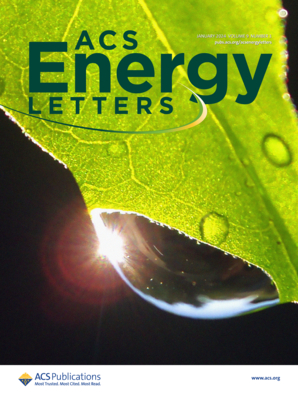Self-Organized Carbazole Phosphonic Acid Additives at Buried Interface Enhance Efficiency of Blue Perovskite LEDs
IF 18.2
1区 材料科学
Q1 CHEMISTRY, PHYSICAL
引用次数: 0
Abstract
Carbazole phosphonic acids (CPAs) that are used in self-assembled monolayers (SAMs) are well-reported. Yet, an understanding of their broader application still needs to be fully established. In this work, we demonstrate that incorporating CPAs into blue quasi-2D perovskite precursors as additives is an effective strategy for fine-tuning phase distribution and enhancing the radiative characteristics of the resultant films. [2-(9H-Carbazol-9-yl)ethyl]phosphonic acid (2PACz) emerges as the most effective molecule for improving device performance. Significantly, when the perovskite film is deposited onto a hole injection structure of ITO/Mg0.1Ni0.9Ox/SAM/poly(9-vinylcarbazole) (PVK), 2PACz preferentially migrates to the PVK/perovskite interface. This phenomenon is driven by the strong interaction between the carbazole components of both PVK and 2PACz, leading to a stabilized interface. Coupled with the controlled phase distribution of the perovskite, this approach results in a marked increase in external quantum efficiency for blue perovskite LEDs, advancing from 11% to beyond 15%. These insights underscore the versatility of CPAs in the development of high-efficiency optoelectronic devices.

埋入式界面上的自组织咔唑膦酸添加剂可提高蓝色包晶发光二极管的效率
用于自组装单层膜(SAMs)的咔唑膦酸(CPAs)已被广泛报道。然而,对其更广泛应用的理解仍有待全面确立。在这项研究中,我们证明了在蓝色准二维包晶前驱体中加入 CPAs 作为添加剂是微调相分布和增强所得薄膜辐射特性的有效策略。[2-(9H-咔唑-9-基)乙基]膦酸(2PACz)是提高设备性能最有效的分子。值得注意的是,当将过氧化物薄膜沉积到 ITO/Mg0.1Ni0.9Ox/SAM/poly(9-vinylcarbazole) (PVK) 的空穴注入结构上时,2PACz 会优先迁移到 PVK/ 过氧化物界面。这一现象是由于 PVK 和 2PACz 的咔唑成分之间的强烈相互作用导致了界面的稳定。这种方法与可控的过氧化物相分布相结合,显著提高了蓝色过氧化物 LED 的外部量子效率,从 11% 提高到 15% 以上。这些见解强调了 CPA 在开发高效光电设备方面的多功能性。
本文章由计算机程序翻译,如有差异,请以英文原文为准。
求助全文
约1分钟内获得全文
求助全文
来源期刊

ACS Energy Letters
Energy-Renewable Energy, Sustainability and the Environment
CiteScore
31.20
自引率
5.00%
发文量
469
审稿时长
1 months
期刊介绍:
ACS Energy Letters is a monthly journal that publishes papers reporting new scientific advances in energy research. The journal focuses on topics that are of interest to scientists working in the fundamental and applied sciences. Rapid publication is a central criterion for acceptance, and the journal is known for its quick publication times, with an average of 4-6 weeks from submission to web publication in As Soon As Publishable format.
ACS Energy Letters is ranked as the number one journal in the Web of Science Electrochemistry category. It also ranks within the top 10 journals for Physical Chemistry, Energy & Fuels, and Nanoscience & Nanotechnology.
The journal offers several types of articles, including Letters, Energy Express, Perspectives, Reviews, Editorials, Viewpoints and Energy Focus. Additionally, authors have the option to submit videos that summarize or support the information presented in a Perspective or Review article, which can be highlighted on the journal's website. ACS Energy Letters is abstracted and indexed in Chemical Abstracts Service/SciFinder, EBSCO-summon, PubMed, Web of Science, Scopus and Portico.
 求助内容:
求助内容: 应助结果提醒方式:
应助结果提醒方式:


